Dental fillings are one of the most popular methods to repair and restore teeth from issues like cavities. They can also be used to repair broken teeth or teeth worn down from nail-biting, tooth-grinding, etc.
To restore a cavity, the dentist will remove the decayed part of the tooth and fill the area where the decayed material was extracted.
In This Article We discuss About How To Choose a Suitable Dental Filling.
Different Types Of Dental Fillings
Composite Fillings
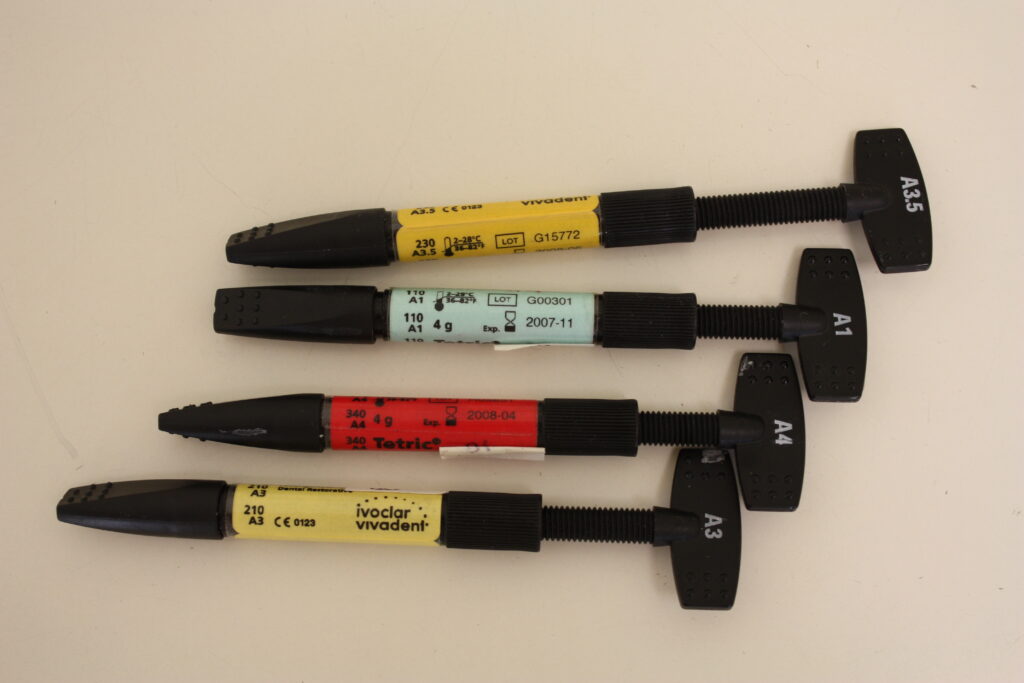
These are composite resin fillings are made of a mixture of materials; plastic and glass powder. This mixture is put into the tooth in putty form and is hardened by a specialized LED light, also known as ‘curing light.’ They are then finished and polished to look exactly like the tooth.
Composite fillings are a popular choice because of being tooth-colored. They are the easiest to blend in with the appearance of natural teeth and hence most aesthetically pleasing. These fillings are used for both the front and back teeth and can be used for cavities, filling gaps, and correcting cosmetic issues.
Composite fillings go through a small amount of shrinkage after they harden and are susceptible to future decay if poorly maintained. They usually need to be replaced every five to ten years.
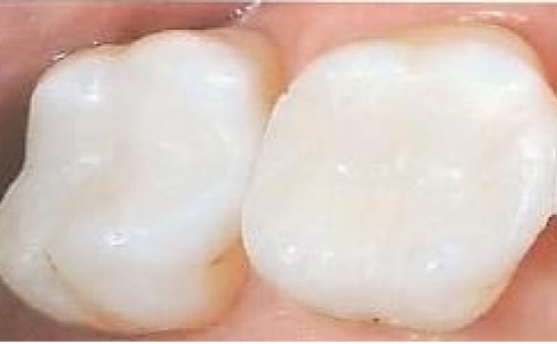
Merits of composite dental filling:
1. Aesthetics: They can blend well with natural teeth as the color of the filling can be customized to match the existing tooth color, making them a popular choice for visible teeth.
2. Durability: They are durable and long-lasting if taken care of properly.
3. Versatile: Composite fillings can be used to address a range of dental issues, including chipped or worn teeth, cavities, and cracked teeth.
4. Minimal tooth reduction: The amount of tooth reduction necessary for placing composite fillings is minimal.
5. Bonding: Composite fillings have strong bonding capabilities that help prevent bacteria from entering, which helps combat tooth decay.
Demerits of composite dental filling:
1. Cost: They can be more expensive than traditional silver fillings.
2. Lifespan: Composite fillings may not last as long as other types of dental fillings.
3. Technique: It takes skill and experience to place a composite filling properly. Not all dentists are trained well in placing composite fillings.
4. Sensitivity: Patients may experience sensitivity or discomfort after the procedure.
5. Teeth staining: Over time, composite fillings may stain and discolor due to drinking coffee, tea, or wine.
Related Article :- What Are The Do’s And Don’ts After Tooth Filling?
Amalgam Fillings
Although they’re thought of as silver fillings, amalgam fillings are actually made of a mixture of fifty percent silver, tin, copper, and a small amount of mercury. The mercury in it usually raises concerns, but the amount used is completely safe to be used as a filling. Mercury also becomes more stable and hence safer when mixed with other materials, keeping it from escaping from the filling.
If you’re looking for aesthetics, these are definitely not the ones for you. They are very noticeable and even tend to get darker over time. being high strength, they are indicated in molars, also known as the teeth used for chewing.

Advantages of Amalgam dental fillings:
1. Durability: Amalgam fillings are long-lasting and are known to withstand pressure and wear-and-tear.
2. Cost-effective: Amalgam fillings are typically less expensive than other types of fillings.
3. Quick application: They can be applied quickly and efficiently.
4. Can withstand chewing pressure: Amalgam fillings can withstand the pressure of chewing and grinding at the back of the mouth.
5. Easy placement: Compared to other types of fillings, placement of amalgam fillings is a faster and easier process.
Disadvantages of Amalgam dental fillings:
1. Aesthetics: Amalgam fillings are silver in color, which can be noticeable when placed in visible teeth.
2. Mercury content: Amalgam fillings contain small amounts of mercury. Although the levels are considered safe by most health authorities, some patients may be concerned about its toxicity.
3. Expansion and contraction of metal: It has been observed that amalgam fillings may expand and contract over time due to temperature changes which can cause cracks or fractures in teeth.
4. Removal process: Removing amalgam fillings can release mercury vapor, which can be harmful if inhaled. Dentists need to take appropriate precautions to minimize risk during removal.
5. Tooth damage: More tooth removal is required to make a stable base for the amalgam to stick to. Hence, there may be more tooth structure loss while placing an amalgam filling than a composite one.
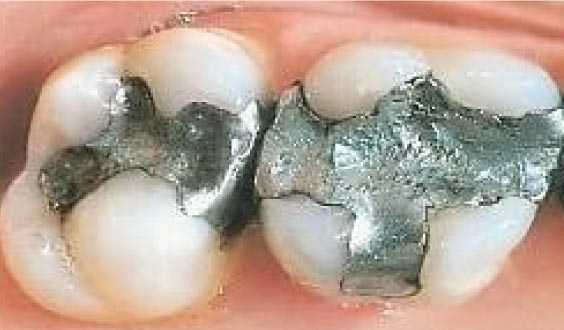
Glass Ionomer Fillings
Glass ionomer fillings are made of acrylic and a component of glass called fluoro aluminosilicate. They are most commonly used for young children since their teeth are still undergoing significant changes. They release fluoride, which can also help protect teeth from further decay, making them a great option for those who get cavities often, like children.
These fillings are dull and do not reflect light, making them slightly less aesthetically pleasing than other ones like composite fillings. They are also weaker than other fillings and can wear down or crack from too much chewing force, limiting their life span to about just five years.

Advantages Of GIC Dental Filling
- shorter setting time, thus better handling properties making it easier for the dentist.
- GIC does not require bond, it can bond to enamel and dentine without the need for use of an intermediate material. Conventional GIC also has a good sealing ability providing little leakage around restoration margins and reducing the risk of secondary caries.
- GIC contains and releases fluoride after being placed therefore it helps in preventing secondary caries.
- It has good thermal properties as the expansion under stimulus is similar to dentine.
- The material does not contract on setting meaning it is not subject to shrinkage and microleakage.
- GIC is also less susceptible to staining and colour change than composite.
Disadvantages Of GIC Dental Filling
- GIC have poor wear resistance, they are usually weak after setting and are not stable in water.
- Due to their low strength GICs are not appropriate to be placed in cavities in areas which bear an increase amount of occlusal load or wear.
- The material is susceptible to moisture when it is first placed.
- GIC varies in translucency therefore it can have poor aesthetics , especially noticeable if placed on anterior teeth.
Related Article :- What Are The Do’s And Don’ts After Tooth Filling?
Silver alloy reinforced glass ionomer fillings
They are formulated using glass ionomer and silver alloy, which surpasses the shortcomings of amalgam and glass ionomer restorations. It forms a strong bond which increases the strength and releases high fluoride that reduces the secondary decay. It does not stain or discolor the surrounding teeth and shrinks and expands like the tooth structure making it durable for a long time. Only disadvantage is the dark radio opaque color of the filling that makes it unsuitable for aesthetics.
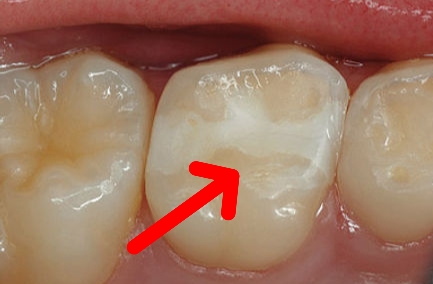
Advantages of silver alloy reinforced glass ionomer dental fillings:
1. Natural look: Glass ionomer fillings are tooth-colored, which can match the color of the teeth making them less noticeable.
2. Chemical bonding: They have excellent chemical bonding with tooth structures, which helps in preventing leakage over time.
3. Fluoride release: Glass ionomer fillings release fluoride, which is particularly helpful in preventing further tooth decay.
4. Minimal tooth removal: The technique for applying glass ionomer fillings requires minimal removal of tooth structure.
5. Cost-effective: Glass ionomer fillings are less expensive when compared to composite fillings.
Disadvantages of silver alloy reinforced glass ionomer dental fillings:
1. Not as durable: Glass ionomer fillings are relatively less durable than other materials such as composite resin, making them unsuitable for chewing surfaces.
2. Sensitivity: Because of the sensitivity of newly placed glass ionomer fillings, patients are advised to avoid consuming hot and cold drinks for a few days.
3. Staining: Although glass ionomer fillings are tooth-colored, their porous nature makes them more vulnerable to staining and discoloration over time.
4. Not suitable for every tooth: Glass ionomer fillings may not be suitable for filling cavities that experience heavy pressure during chewing and biting.
5. May need topping off: In some cases, glass ionomer fillings may need to be topped off with another filling material to make them more durable.
Overall, silver alloy reinforced glass ionomer dental fillings are a viable option for restoring minor tooth decay, especially in children, seniors, and people with a limited budget. However, they may not be the most suitable material for larger cavities or teeth that experience heavy pressure during chewing. As always, it is best to consult with your dentist to determine the best filling material for your dental needs.
Ceramic Fillings
Ceramic fillings are made of porcelain. They can also match the color of your teeth and are more durable than composite fillings. These fillings are used for inlays, onlays, implants, crowns, and veneers.
Ceramic fillings tend to last longer than composite and amalgam fillings and are hence costlier and a little more time-consuming to finish. They are more resistant to staining and abrasion than some other types of fillings.
Although they are tooth-colored, they need to be bigger to prevent them from breaking. The procedure, is slightly different from other ones since empty space needs to be enlarged, to make room for the filling. They are not indicated in all cases, this can be decided by the dentist on examination.
Advantages of ceramic dental fillings:
1. Natural look: Ceramic fillings match the color of natural teeth, making them a good option for front teeth where aesthetics are critical.
2. Durability: Ceramic fillings are strong and durable, made to withstand the forces of biting and chewing, making them suitable for larger cavities.
3. Allergen-free: Ceramic fillings do not contain any metals, making them a good option for people with allergies.
4. No mercury: Ceramic fillings do not contain any mercury, which can give people peace of mind if they are concerned about exposure to mercury.
Disadvantages of ceramic dental fillings:
1. Expensive: Ceramic fillings are more expensive than other types of fillings due to the materials and skilled labor involved in their manufacture.
2. Time-consuming: The process of placing ceramic fillings requires more time than traditional fillings.
3. Brittle: Ceramic fillings can be brittle and may chip or crack if exposed to excessive pressure.
4. Fractures: Ceramic fillings may not be suitable for people who grind their teeth as the ceramic material may fracture under intense pressure.
5. Sensitivity: Newly placed ceramic fillings may cause some sensitivity to temperature changes in the mouth for a few days.
Overall, ceramic dental fillings are a good option for those who want a natural-looking filling material that is strong and durable. While they may be more expensive than traditional fillings, they provide a longer-lasting solution and may be a better option for larger cavities. It is best to discuss the available options with your dentist to determine the best filling material for your unique situation.
Resin Modified Glass Ionomer
Resin modified glass ionomer was developed to combine the properties of glass ionomer cement with composite technology. It comes in a powder-liquid form.It also has photoinitiators present which enable light curing.
Advantages
- Provides a good bond to enamel and dentine.
- It has better physical properties than GIC.
- A Lower solubility in moisture.
- It also releases fluoride over time.
- Provided better translucency and aesthetics as compared to GIC.
- Better handling properties making it easier to use.
Disadvantages
- Polymerisation Contraction can cause microleakage around restoration margins
- It has an exothermic setting reaction which can cause potential damage to tooth tissue.
- The material swells due to uptake of water
- Monomer leaching : It is toxic to the pulp therefore it must be polymerised completely.
- The strength of the material reduces if its not light-cured.
Dental Filling Cost
The cost of dental fillings varies depending on the location, type of filling, and the extent of the dental work required.
Here is an estimated cost range for common types of dental fillings:
1. Amalgam fillings:
Amalgam fillings, also known as silver fillings, are typically the least expensive option and cost anywhere from $75 to $150 per tooth.
2. Composite resin fillings:
Composite resin fillings, also known as tooth-colored fillings, cost between $90 to $250 per tooth. They are slightly more expensive than amalgam fillings because they require more time and skill to place.
3. Ceramic fillings:
Ceramic fillings are the most expensive option, costing between $250 to $4,500 or more per tooth. Ceramic fillings are usually used for restoring front teeth, where aesthetics are critical.
4. Glass ionomer fillings:
Glass ionomer fillings cost between $75 to $200 per tooth and are typically used for filling small cavities in children and for cavities that are not under heavy pressure from chewing.
It is important to note that these cost estimates may vary depending on the dentist, location, and the extent of dental work required. It is best to discuss the cost and options with your dentist to come up with a treatment plan that fits your needs and budget. Additionally, dental insurance may cover a portion of the cost of dental fillings.
Related Article :- What Are The Do’s And Don’ts After Tooth Filling?
Dental Filling Procedure



The procedure for dental filling typically involves the following steps:
1. Numbing the area – The dentist will administer a local anesthetic to numb the affected tooth and the surrounding area.
2. Removing decay – The dentist will use a drill or other instrument to remove the decayed part of the tooth.
3. Cleaning the cavity – The dentist will then clean the cavity thoroughly to remove any bacteria or debris.
4. Filling the cavity – The dentist will fill the cavity with the chosen filling material, such as amalgam, composite, or porcelain.
5. Polishing the filling – The dentist will polish the filling to remove any rough edges and ensure that it fits comfortably with the opposing teeth.
6. Checking your bite – The dentist will check your bite to ensure that the filling is not interfering with your natural bite.
7. Finishing – The dentist will provide post-treatment instructions and schedule any necessary follow-up appointments.
How Long Does Dental Filling Procedure Take?
The procedure for dental filling usually takes about 30 minutes to an hour, depending on the size of the cavity and the type of filling material used. In some cases, multiple appointments may be required to complete the procedure, depending on the severity of the decay.
Related Article :- What Are The Do’s And Don’ts After Tooth Filling?
Which is the best option for you?
Your choice of dental fillings can depend on cost, your personal aesthetic choices, and a lot more.
- If you want tooth-colored fillings that look like your teeth and blend in, composite or ceramic fillings could be the best choice for you. Your dentist might also suggest composite dental fillings if there is a lot of chewing force.
- If you are looking for fillings that release fluoride and further protect your teeth from damage, you could go for glass ionomer fillings. They can be colored to blend with neighbouring teeth and help prevent further decay. This also makes them a great option for children.
- Amalgam fillings or silver alloy reinforced gi fillings could be a good option for you if you’re looking for affordable, long-lasting fillings, crowns, fixed bridges, etc.
Even though these above-mentioned dental fillings are common practice now, the best way to go is still prevention and avoidance of the need for repair. Following good oral hygiene and visiting your dentist for regular checkups can go a long way.
Conclusion
There are several types of dental fillings available, each with their own advantages and disadvantages. The choice of filling material depends on several factors like the location of the tooth, the extent of the decay, the patient’s age, dental history, and budget. The traditional amalgam fillings, with their durability and cost-effectiveness, have been used for over 150 years. However, they are declining in popularity due to their aesthetics and mercury content. The newer composite fillings are made of tooth-colored material, which makes them more appealing. They also require less tooth removal, allowing for a more conservative approach. Other materials like porcelain, gold alloy, or glass ionomers may be used in specific cases. Ultimately, it is up to the dentist and patient to determine the best filling material for maintaining good oral health. Whatever filling is chosen, it is critical to remember that good dental hygiene, including daily brushing and flossing, bi-annual dental exams, and routine cleanings, is necessary to maintain a healthy mouth and prevent the need for future fillings.
Related Article :- What Are The Do’s And Don’ts After Tooth Filling?

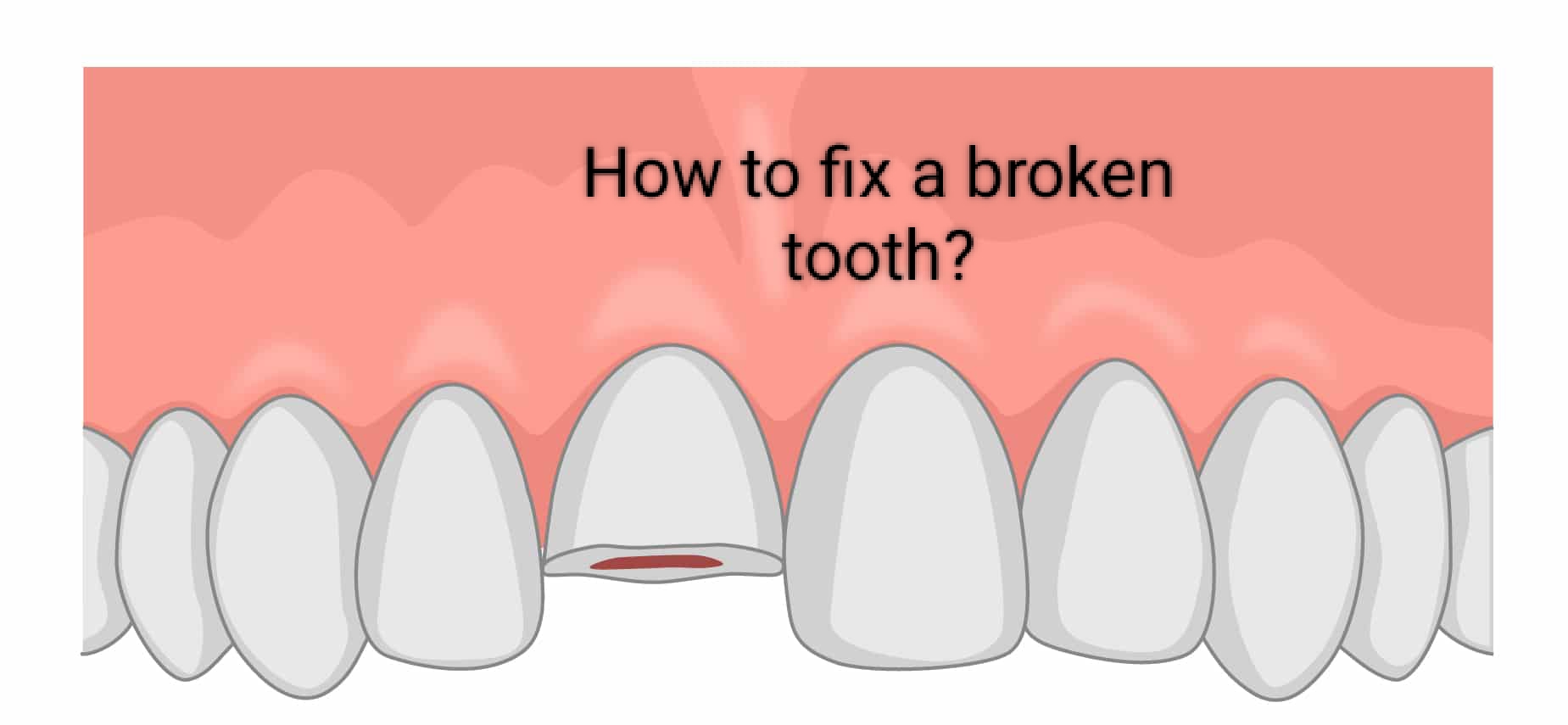

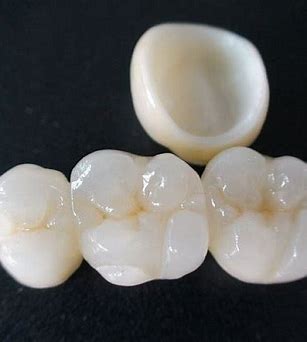
One thought on “Dental Filling Material Or Dental Restorations: An Ultimate Guide To Selection (With Cost)”